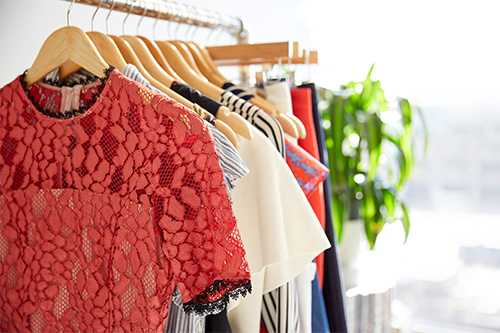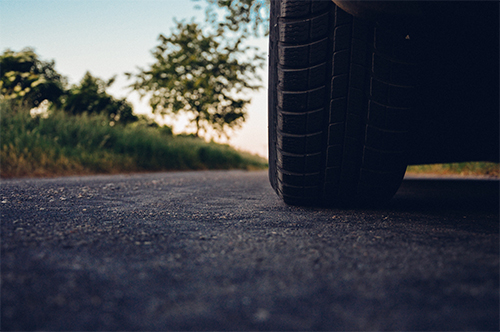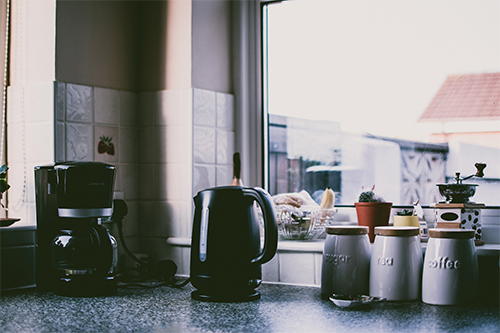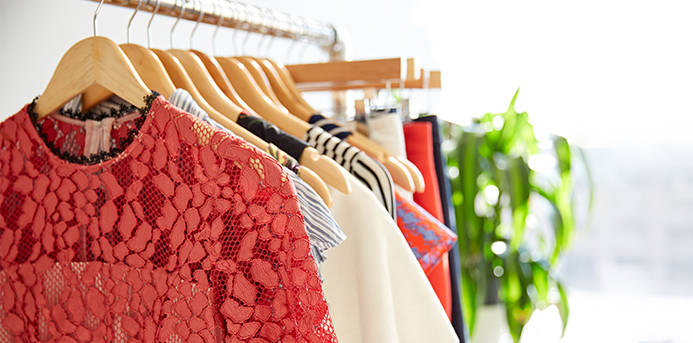Some eco-friendly habits require a big investment, like installing solar-panels on your roof or trading in your car for an electric vehicle. But, there are plenty of simple habits that we can easily implement to start living greener today.
Here are nine easy ways to adopt a more eco-friendly lifestyle right now.
1. Try a clothing rental service

Have you been watching “Tidying Up with Marie Kondo” on Netflix? Did you take her advice and make a mountain out of your clothes and sort through them, saying thank you and goodbye to the items that no longer spark joy? If you’ve done a closet cleanout recently — regardless of whether it was with the KonMari method or not — you probably realized that you have way too many pieces of clothing that aren’t getting worn, and some that may even still have the tags on them.
The fashion industry produces about 92 million tons of waste, and the demand for fast fashion (inexpensive, trendy clothing) continues to drive that figure upward.
But, what if you could always feel like you have something “new” to wear, without all the waste? Enter clothing subscription services. I’ve tried both Le Tote‘s and Rent the Runway’s unlimited memberships. Hands down, my favorite is Rent the Runway. (I got a year-end e-mail from them saying I rented $18,808 worth of clothes since I started paying $159 for my membership in September). Here’s how it works: You get to choose four items at a time (clothing and accessories) from 500-some designers like Jason Wu (who has designed for Michelle Obama), Tanya Taylor (who recently dressed “This Is Us” actress Chrissy Metz for the Golden Globes), Christian Siriano, and more. Instead of several women buying one cheap dress at a mall store, you’re essentially sharing a designer style with other fashionistas, and the dress gets worn over and over again.
According to Rent the Runway, the average woman throws away 82 pounds of clothes each year. Renting clothes is a more sustainable approach. Being green? That looks good on everyone.
Bonus: Rent the Runway only has a handful of brick-and-mortar stores. One is in Chicago and another is in San Francisco, so you can swap out your rental clothes in the store in addition to placing orders online.
2. Switch to a low-flow showerhead
No need to do a full-on shower renovation. Simply switching your showerhead to a low-flow model will help your household save water (and money). Standard showerheads use 2.5 gallons per minute (gpm), but those with the WaterSense label use 2 gpm or less. You’ll save not only on your water bill, but also on your energy bill because a more efficient shower will mean you won’t be heating as much water. Try this calculator from the Environmental Protection Agency to determine how much water you can save and how much your bill could go down.
But don’t stop there. Try this water-saving trick suggested by Pablo Solomon, an artist and award-winning designer who has been recognized for his environmental designs. Put a dishpan in your sinks, tubs, and showers that can collect the water you waste while you are waiting for it to warm up, he suggests. Then, use that water for your plants.
3. Check your tire pressure

When that “check tire pressure” light comes on, take that as your cue to fill up on air. Under-inflated tires reduce mileage by as much as 10 percent, and every 5 miles per hour over 50 MPH is equivalent to a $0.21 reduction in fuel efficiency, says Gay Browne, founder of Greenopia, a city guide of sustainable businesses. It only costs a few bucks to keep the air in your tires fully inflated, so this can be an easy habit to adopt, says Browne, the author of “Living With a Green Heart: How to Keep Your Body, Your Home, and the Planet Healthy in a Toxic World.”
4. Ditch the cold-pressed juice
A hydraulic press to extract juice from fruit and veggies gives way to cold-pressed juices, which have become a buzzy post-workout or morning drink. But, Browne says, the juices aren’t very healthy for the environment. Just one 16-ounce cold-pressed juice creates 3.5 pounds of pulp waste. Pulp waste in landfills exceeds 175,000 tons a year, according to Modern Farmer. The methane generated from the decaying pulp is equivalent to 200,000 tons of carbon dioxide emitted into the atmosphere. Browne’s suggestion? Drink more water infused with fresh fruit — from an eco-friendly water bottle, of course!
5. Keep appliances unplugged when not in use

Trim down your energy use (and bill!) by getting in the habit of unplugging appliances when they’re not in use, suggests sustainability expert Sarah Hancock, who manages a blog dedicated to educating home and business owners about solar energy. On average, Americans have about 50 household appliances they routinely leave plugged in and that are drawing power. (Ahem, coffee makers! Toasters! Hair dryers!) These energy-sucking “vampires” can easily cost households $100 to $200 a year, according to the U.S. Department of Energy.
A few more notorious energy vampires include:
- Electric shavers and electric toothbrush stations in the bathroom
- Blenders and electric tea kettles in the kitchen
- DVRs, streaming devices, and video gaming equipment in the living room
- Computers and printers in the home office
An easy way to control energy use from these sorts of devices? Plug them into a smart power strip that you can easily turn off when the devices aren’t in use.
6. Switch up your laundry and dishwashing routines
Most cleaning products are sold in big, plastic jugs. We’re wagging our fingers at you, laundry and dishwasher detergents. Make the switch to refillable products or opt for brands that use biodegradable packaging. For example, Dropps laundry detergent pods and dishwasher detergent pods come in recyclable, repulpable, and compostable cardboard boxes and without all of the plastic waste. Next, ditch dryer sheets that are made from synthetic plastic fiber and replace them with reusable wool dryer balls. The dryer balls tumble around with your clothes, reducing drying time by absorbing moisture and preventing clothes from twisting, knotting, and wrinkling. They also work to soften your clothes, but without the chemicals used in dryer sheets.
7. Pledge to plant a tree this year

Plant a tree and reap the benefits. Trees not only create habitats for birds and other animals, but they also release oxygen while absorbing carbon dioxide and other harmful pollutant gasses, like carbon monoxide. Shade from trees can slow down water evaporation from thirsty lawns so they require less watering. Come summer time, trees can even help reduce air conditioning use by shading our homes and keeping neighborhoods cooler.
8. Become a part-time vegetarian or vegan
You don’t have to go full-on vegan or vegetarian to help out Mother Earth. Embracing #MeatlessMonday and scaling back on meat and dairy throughout the week can be a boon for the environment. Research from the University of Oxford published in “Science” found that meat and dairy production accounts for the vast majority of farmland usage and produces 60 percent of agriculture’s greenhouse gas emissions. If you are interested in giving a full-on vegan diet a test run, Veganuary — a challenge to eat vegan for a month — has resources like meal plans, recipes, and dining-out tips.
9. Carry a reusable water bottle
Combat single-use plastic by investing in a reusable water bottle that will last you years and save you big bucks over time, suggests Hancock. The average American uses 167 disposable water bottles annually, but only recycles 38 of those. That translates to 38 billion water bottles, or more than $1 billion worth of plastic, being wasted every year. “If you purchased a reusable water bottle now and used it in place of plastic bottles for five years, that’s almost $500 in savings,” Hancock says.
The takeaway? It actually is easy to be green!
 Brittany Anas is a freelance writer who specializes in health, fitness, and travel writing. She also contributes to Men’s Journal, Women’s Health, Trip Savvy, Simplemost, Orbitz, and Eat This, Not That! She spent a decade working at daily newspapers, including The Denver Post and the Daily Camera in Boulder, Colorado, and she is a former federal background investigator. In her free time, Brittany enjoys hiking with her gremlin-pot belly pig mix that the rescue described as a “Boston Terrier” and coaching youth basketball. She also works with domestic abuse survivors, helping them regain financial stability through career coaching. Follower her on Twitter and Instagram.
Brittany Anas is a freelance writer who specializes in health, fitness, and travel writing. She also contributes to Men’s Journal, Women’s Health, Trip Savvy, Simplemost, Orbitz, and Eat This, Not That! She spent a decade working at daily newspapers, including The Denver Post and the Daily Camera in Boulder, Colorado, and she is a former federal background investigator. In her free time, Brittany enjoys hiking with her gremlin-pot belly pig mix that the rescue described as a “Boston Terrier” and coaching youth basketball. She also works with domestic abuse survivors, helping them regain financial stability through career coaching. Follower her on Twitter and Instagram.

